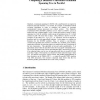65 search results - page 12 / 13 » When does a correct mutual exclusion algorithm guarantee mut... |
ALGOSENSORS
2009
Springer
14 years 1 months ago
2009
Springer
Sensor networks, with their ad hoc deployments, node mobility, and wireless communication, pose serious challenges for developing provably correct and efficient applications. A po...
ICWN
2003
13 years 8 months ago
2003
— Most wireless systems receive a license that gives them exclusive access to a block of spectrum. Exclusivity guarantees adequate quality of service, but it also leads to inef�...
MICRO
2010
IEEE
13 years 5 months ago
2010
IEEE
Abstract--Many shared-memory parallel systems use lockbased synchronization mechanisms to provide mutual exclusion or reader-writer access to memory locations. Software locks are i...
CORR
2007
Springer
13 years 7 months ago
2007
Springer
— We analyze the feasibility of distributed spatial multiplexing with limited feedback in a slow-fading interference network with MN non-cooperating single-antenna sources and M ...
CIAC
2000
Springer
13 years 11 months ago
2000
Springer
A minimum spanning tree (MST) with a small diameter is required in numerous practical situations. It is needed, for example, in distributed mutual exclusion algorithms in order to ...

